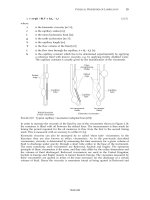Crc Press - Mechanical Engineering Handbook - Robotics 1 Part 10 pdf
Bạn đang xem bản rút gọn của tài liệu. Xem và tải ngay bản đầy đủ của tài liệu tại đây (24.39 KB, 1 trang )
14-90 Section 14
© 1999 by CRC Press LLC
14.11 Industrial Material Handling and Process Applications of
Robots
John M. Fitzgerald
Replacing humans with robots to perform processes has often led to failure. The reason is that the robots
are often mechanically capable of the manipulation while being incapable of process planning and
control. Thousands of robot installations have failed because replacing the manual method with the
automatic method lacked adaptability to process related variation. The human operators had been using
their cognitive abilities to do the job. A vast majority of successful robot implementations past and
present have a very important common aspect: repeated execution of fixed programs with little or no
on-line modification of path or position.
Process robot planning and programming still usually require the efforts of highly skilled technicians.
Often, complex programs cost too much and take too long. Continuously controlling and varying path
manipulation parameters for real-time process control is difficult. Many processes are not known well
enough to describe their control algorithmically. In a few applications sensors are becoming more
common for adapting robot plans to changes in the environment. Setup, seam tracking, positioning,
conveyor tracking, and now automatic programming for painting and finishing are becoming practical
as sensor costs and computation costs continue to decline.
In this section robotic material handling and process applications are presented from an automation
system perspective focusing on the robot’s manipulation functions. Manipulation is considered a man-
ufacturing material transformation and a transportation process factor. Programming and control are
viewed as the means of integrating robot manipulation as part of the manufacturing process. The reader
who is interested in a specific application is encouraged to first review the relevant process technology
sections of this book.
Implementation of Manufacturing Process Robots
Manipulation as a Process Requirement
The starting point of automation system design is a thorough understanding of the process to be
automated. Implementation of a process robot requires a focus on manipulation as a process factor. The
pose and path requirements of the process are independent of the manipulator used.
It is useful to conduct a static spatial analysis of manipulation requirements and then examine the
mechanical and dynamic requirements when designing or selecting a process robot manipulator.
A spatial description of the relative positions and orientations of the workpiece and tool during
processing provides the basis for describing the required manipulation. Tool poses are graphed in an
appropriate reference frame, usually the frame of the workpiece, or in the case of machine loading, the
work holding fixture may be used. Path requirements are secondary for these applications. The path
taken does not affect the process. For continuous path processes entire paths must be graphed or mapped.
If continuous analytical descriptions of the path are not available, a sampling of discrete points along
the required path can be used to represent the space occupied by the path. The result in both cases is a
Cartesian mapping of spatial requirements of pose and path. A description of the pose and path precision
requirements should be included. Next the mechanical and dynamic requirements are defined. Payload
and force reactions at each position and along the path must be understood. Other important dynamic
requirements such as acceleration and power should be quantified. The manipulation requirements are
the basis for design and selection of both the robot arm and the controller.
Manipulation Capability of Process Robots
The basic mechanical capability of the robot mechanism to perform the manipulation work is determined
by its mechanical structure, kinematic configuration, and drive mechanism. There are several applications
including painting, palletizing, spot welding, and arc welding for which specific types of robot arm









